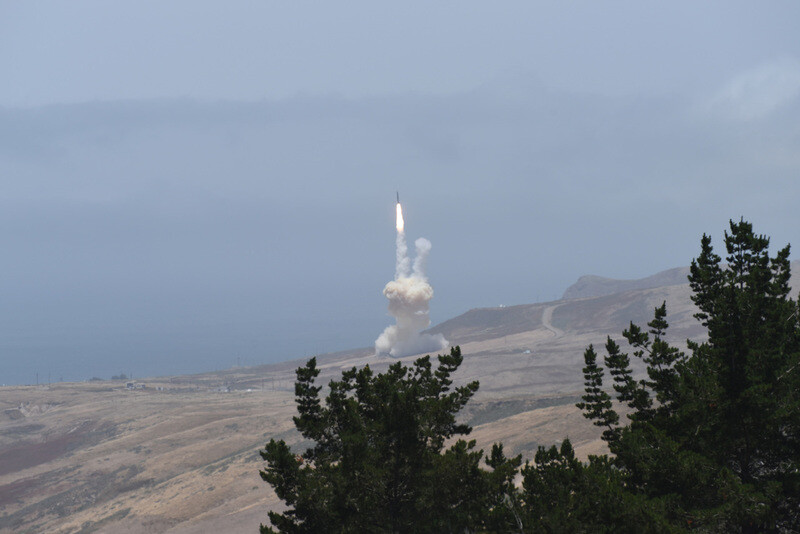hankyoreh
Links to other country sites 다른 나라 사이트 링크
US holds first successful test interception of an ICBM

The US succeeded in its first intercontinental ballistic missile (ICBM) interception test, the US Missile Defense Agency (MDA) reported on May 30. US news outlets said the test was intended to prepare for the possibility of a North Korean ICBM attack on the mainland US.
“During the test, an ICBM-class target was launched from Reagan Test Site on Kwajalein Atoll in the Republic of the Marshall Islands,” the MDA reported in a press release.
“A ground-based interceptor was launched from Vandenberg Air Force Base, California, and its exo-atmospheric kill vehicle intercepted and destroyed the target in a direct collision,” it continued.
MDA director Vice Adm. Jim Syring was quoted as saying, “The intercept of a complex, threat-representative ICBM target is an incredible accomplishment for the GMD [ground-based midcourse defense] system.”
The test intercept of an ICBM was the first attempted by the US. It was the 18th missile interception exercise carried out since 1999, ten of which were successful. While US authorities did not go on record that the test was targeting North Korea, news outlets interpreted that as its aim.
The MDA did not release specific information about the test or its conditions. But the test does appear to have taken place under controlled conditions, as in the past. For this reason, experts are predicting more difficulties with interception and a lower probability of success in the field. No interception test has yet been staged at night.
Critics are also questioning whether the test is capable of providing defense against an actual North Korean ICBM. Physicist Laura Grego of the Union of Concerned Scientists wrote on her blog on May 19 that maritime navigation warnings suggested the interception test was for a missile with a range of 5,800 km. Since the category of “ICBM” applies to missiles with a range of 5,500 km or more, the interception test appears to have been performed for a missile at the short end of that range. If North Korea were to develop an ICBM for launch toward the western continental US, the range would be around 10,000 km. This would translate into a much faster descent speed, meaning that the interception capabilities in the test are unlikely to offer much of a defense against North Korean ICBMs.
ICBMs also confuse interception missiles in outer space by producing numerous decoys. Missile experts said it was more or less impossible for an interception missile to tell the decoy warheads from real ones.
The New York Times noted that North Korea launched four medium-range ballistic missiles on Mar. 6 from near the village of Tongchang in North Pyongan Province, whereas the recent test only measured the defense system’s ability to intercept a single missile.
By Yi Yong-in, Washington correspondent
Please direct questions or comments to [english@hani.co.kr]

Editorial・opinion
![[Column] Life on our Trisolaris [Column] Life on our Trisolaris](https://flexible.img.hani.co.kr/flexible/normal/500/300/imgdb/original/2024/0505/4817148682278544.jpg) [Column] Life on our Trisolaris
[Column] Life on our Trisolaris![[Editorial] Penalties for airing allegations against Korea’s first lady endanger free press [Editorial] Penalties for airing allegations against Korea’s first lady endanger free press](https://flexible.img.hani.co.kr/flexible/normal/500/300/imgdb/original/2024/0502/1817146398095106.jpg) [Editorial] Penalties for airing allegations against Korea’s first lady endanger free press
[Editorial] Penalties for airing allegations against Korea’s first lady endanger free press- [Editorial] Yoon must halt procurement of SM-3 interceptor missiles
- [Guest essay] Maybe Korea’s rapid population decline is an opportunity, not a crisis
- [Column] Can Yoon steer diplomacy with Russia, China back on track?
- [Column] Season 2 of special prosecutor probe may be coming to Korea soon
- [Column] Park Geun-hye déjà vu in Yoon Suk-yeol
- [Editorial] New weight of N. Korea’s nuclear threats makes dialogue all the more urgent
- [Guest essay] The real reason Korea’s new right wants to dub Rhee a founding father
- [Column] ‘Choson’: Is it time we start referring to N. Korea in its own terms?
Most viewed articles
- 1New sex-ed guidelines forbid teaching about homosexuality
- 2OECD upgrades Korea’s growth forecast from 2.2% to 2.6%
- 360% of young Koreans see no need to have kids after marriage
- 4[Column] Life on our Trisolaris
- 5[Guest essay] Maybe Korea’s rapid population decline is an opportunity, not a crisis
- 6Months and months of overdue wages are pushing migrant workers in Korea into debt
- 7Presidential office warns of veto in response to opposition passing special counsel probe act
- 8Inside the law for a special counsel probe over a Korean Marine’s death
- 9Two lung cancer deaths at Samsung Electronics deemed occupational in nature
- 10Korean government’s compromise plan for medical reform swiftly rejected by doctors